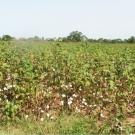
Cotton farming in West Africa is a potentially lucrative, but high-risk opportunity for small-scale farmers. Given cotton’s high cost of cultivation, as well as its vulnerability to the region’s extreme weather patterns, events such as drought can be devastating to farmers. As a result, farmers in the region often minimize their exposure to risk by limiting their cotton cultivation.
While this risk management strategy reduces fluctuations in income, it reduces income every year for the farmer. Index insurance is a promising alternative form of insurance that can reduce risk while allowing farmers to pursue higher income opportunities. However, achieving these index insurance results requires a contract that works.
Project Summary
As part of the Index Insurance Innovation Initiative (I4) of the Feed the Future Innovation Lab for Assets and Market Access at UC Davis, a team of researchers designed an innovative multi-scale index insurance product that pays farmers when they most need help. The multi-scale design minimizes contract failure while still ensuring that it limits opportunities for moral hazard.
An innovation of the insurance design is the use of a double trigger. The insurance is triggered when the group’s area yield reaches a certain level and when the neighboring group’s area yields also fall below a (higher) threshold. In partnership with private sector implementation partners, the research team will conduct an evaluation of both the efficacy of this contract design and the impact on the wellbeing of the small-scale farmers who purchase the insurance.
A secondary goal is to better understand the dynamics of the joint-liability credit groups which these groups of cotton producers form. To do so, the team has already randomized the intensity of monitoring of these groups by the agents managing these groups for two consecutive years. They are also analyzing the impact of this increase in external monitoring on internal monitoring inside the group, sanctioning inside the group and input diversion.
Anticipated Impacts
The team conducted an analysis on 12 years of data from nearly 500 village cotton groups in Burkina Faso to learn how the index insurance contract would have performed had these groups been insured. In years of severe loss, a conventional single-scale index insurance product would have paid the full insured amount 30 percent of the time, paid lesser amounts roughly 35 percent of the time and failed completely 35 percent of the time. Dual strike-point insurance would have paid correctly 85 percent of the time and failed only 15 percent of the time.
By better understanding the behavioral responses to index insurance, researchers and partners can better design insurance products and marketing mechanisms that generate demand and uptake of these risk-mitigating financial tools among smallholder farmers.


